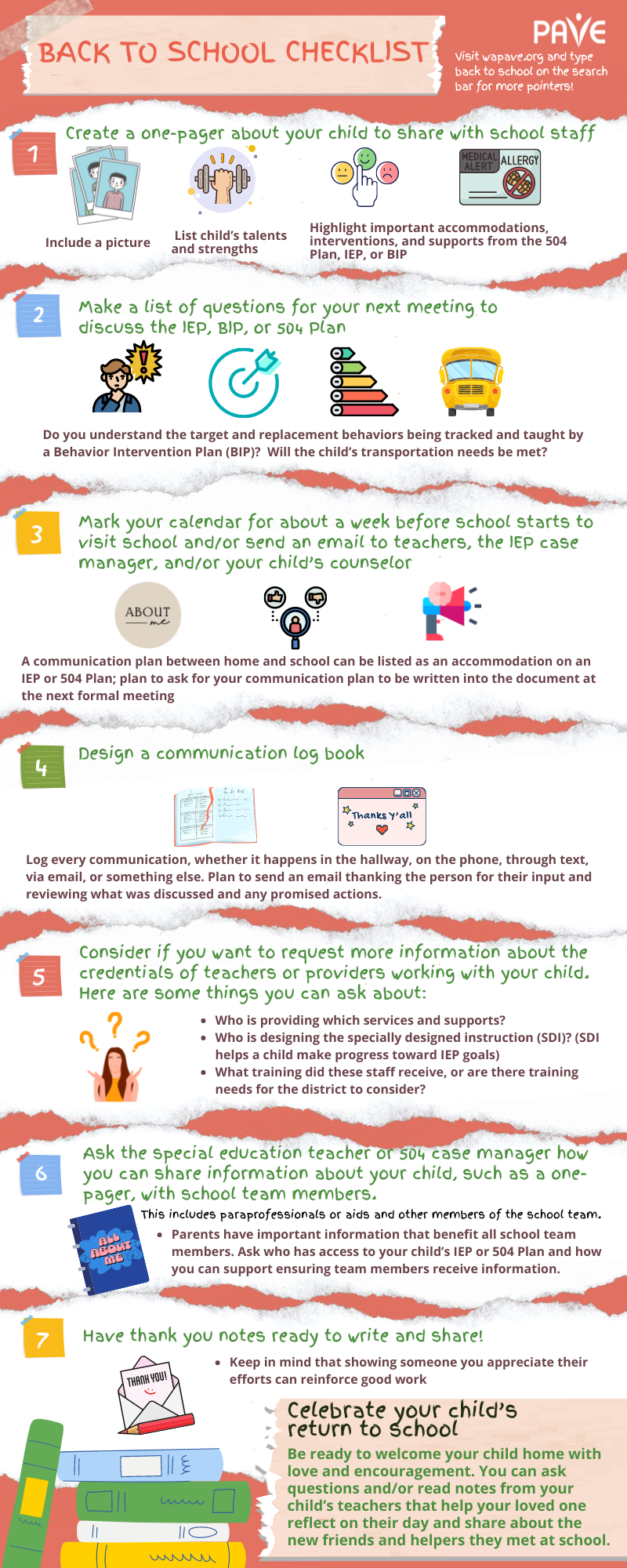Late summer is the time to gather school supplies, find out what time the school bus will pick up and drop off, and prepare to find new classrooms and meet new teachers. Parents of students with disabilities have some additional things to check off the list to be ready for the year ahead. As August is National Immunization Month, we are adding updated immunizations and flu and covid boosters to the reminders. These are fully covered medical expenses whether you have insurance or not and can go a long way to keeping your child and your family healthy as we move into the fall and winter months. There are multiple events across our state where families can go to for immunizations.
Super important: As school begins, make sure you know what’s included in your child’s Individualized Education Program (IEP), Section 504 Plan, and/or Behavior Intervention Plan (BIP). For more, see PAVE’s article: Tips to Help Parents Plan for the Upcoming School Year.
If you are new to Washington State, perhaps because of military service, you also may want to review some basic information about how education and special education are structured and delivered here. PAVE provides an article: Help for Military Families: Tips to Navigate Special Education Process in Washington State.
Here’s a checklist to help you get organized:
- Create a one-pager about your child to share with school staff
- Include a picture
- List child’s talents and strengths—your bragging points
- Describe behavioral strategies that motivate your child
- Mention any needs related to allergy, diet, or sensory
- Highlight important accommodations, interventions, and supports from the 504 Plan, IEP, or BIP
- Make a list of questions for your next meeting to discuss the IEP, BIP, or 504 Plan
- Do you understand the goals and what skills your child is working on?
- Do the present levels of performance match your child’s current development?
- Do accommodations and modifications sound likely to work?
- Do you understand the target and replacement behaviors being tracked and taught by a Behavior Intervention Plan (BIP)?
- Will the child’s transportation needs be met?
- Mark your calendar for about a week before school starts to visit school and/or send an email to teachers, the IEP case manager, and/or your child’s counselor
- Share the one-pager you built!
- Ask school staff how they prefer to communicate—email, phone, a notebook sent back and forth between home and school?
- Get clear about what you want and need, and collaborate to arrange a communication plan that will work for everyone
- A communication plan between home and school can be listed as an accommodation on an IEP or 504 Plan; plan to ask for your communication plan to be written into the document at the next formal meeting
- Design a communication log book
- Can be a physical or digital notebook
- Plan to write notes every time you speak with someone about your child’s needs or services. Include the date, the person’s full name and title, and information about the discussion
- Log every communication, whether it happens in the hallway, on the phone, through text, via email, or something else
- After every communication, plan to send an email thanking the person for their input and reviewing what was discussed and any promised actions—now that conversation is “in writing”
- Print emails to include in your physical log book or copy/paste to include in a digital file
- Having everything in writing will help you confirm what did/didn’t happen as promised: “If it’s not written down, it didn’t happen.”
- Consider if you want to request more information about the credentials of teachers or providers working with your child. Here are some things you can ask about:
- Who is providing which services and supports?
- Who is designing the specially designed instruction (SDI)? (SDI helps a child make progress toward IEP goals)
- What training did these staff receive, or are there training needs for the district to consider?
- Ask the special education teacher or 504 case manager how you can share information about your child, such as a one-pager, with school team members. This includes paraprofessionals or aids and other members of the school team.
- Parents have important information that benefit all school team members. Ask who has access to your child’s IEP or 504 Plan and how you can support ensuring team members receive information
- Have thank you notes ready to write and share!
- Keep in mind that showing someone you appreciate their efforts can reinforce good work
- Celebrate your child’s return to school
- Do the bus dance on the first morning back to school!
- Be ready to welcome your child home with love and encouragement. You can ask questions and/or read notes from your child’s teachers that help your loved one reflect on their day and share about the new friends and helpers they met at school
Below is an infographic of the above information.
Tip! you can click on the image and access an accessible PDF to print and keep handy.

Click to access an accessible PDF of the infographic above
We also have this infographic in 8.5 x 11 easy to print size! Access it now!

